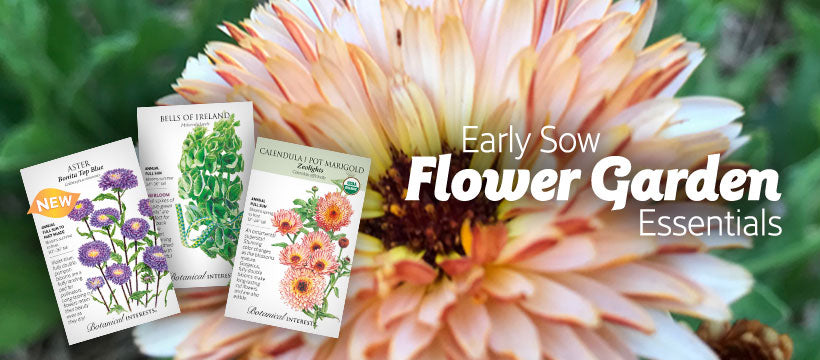
GENERAL SOWING
Potatoes are a frost-sensitive crop, so you want to be sure to get them started early enough so that you can harvest before fall frost.
When to Sow Outside: Not recommended, due to the length of time from sowing to maturity.
When to Start Inside: 4 to 6 weeks before your average last frost date. In mild climates, start seeds in mid-summer for a fall crop. Ideal soil temperature for germination is 60°-70°F.
INDOOR SOWING
Use a lightweight seed starting mix/medium (sterile, and lighter than potting mix), and sow seeds ¼″ deep. Sow 1 or 2 seeds per container, thinning to the strongest plant once leaves appear (clip extra plants at the soil level using scissors). The strongest plant may not be the tallest; look for thick, strong stems and deep color. By thinning early, you minimize the negative impact of crowding, like stretching for light. Read about more indoor sowing tips.
Containers
Containers should be clean, sanitized and have drainage holes. If you choose to sow in cell packs, you may need to up-pot seedlings once into larger containers before transplanting outside.OUTDOOR GROWING
Soil
Soil should be rich and well drained.Transplanting
Plant seedlings 12″ apart, deeply or in a furrow, leaving just two branching leaflets above ground. Once vigorous summer growth starts, you will hill soil up around the stems (see Special Care) gradually filling in the furrow. Water plants after transplanting and mulch (straw is ideal) if you can.
Water
Keep consistently moist with 1"-2" of water per week.Fertilization
A soil test is the best way to know what, if any, amendments are needed. If plants aren't progressing in general growth, you can try adding balanced fertilizer (equal parts nitrogen, phosphorus, and potassium) or hilling plants with compost.Weeding
Keep plants well weeded, especially when small. Weeds compete with crops for light, nutrients, and water, and can harbor insects and diseases.Special care
Potatoes should have soil hilled around them a few times during the growing season to maximize your harvest. When soil is mounded, or hilled, on the plant stems, it encourages new roots to sprout from the buried stem, and more potatoes will develop on those roots. Hilling also preserves the harvest because if/when potato tubers are exposed to light for long periods of time, they produce chlorophyll and other substances that make them bitter. At least one of these substances, solanine, is toxic to humans in large amounts.

Hilling process: As plants grow, mound soil and/or compost around them a few times during the growing season until you have hilled about 12" of soil around plants. It is a good idea to also mulch the hills to reduce weeds, retain moisture, and help prevent pests (see Pest Control). Alternatively, some gardeners plant potatoes in a barrel, grow bag, or similar structure, and add soil and/or compost as plants grow. To harvest, the structure can be opened or tipped over, exposing the potatoes.
HARVESTING
Use a flat-tine digging fork or shovel, digging widely around the hill to avoid damaging the potatoes. Potatoes may be harvested in stages for a longer harvest period. If you grew potatoes in a container, you can also tip the container over, emptying out the potatoes and growing medium.Fresh, new potatoes
Harvest may begin any time after plants have begun to flower. Potatoes harvested at this stage should be enjoyed as soon as possible, as their soft skins don't allow for long-term storage.Storage potatoes
Once the foliage has died back or is removed, potato skins toughen which protects them from drying out, extending their storage life. Harvest 2 to 3 weeks after the foliage has died back. If your season is short and foliage has not died back, you can cut the plants down at the soil level three weeks prior to harvesting.
Curing Storage Potatoes: Unwashed potatoes should be cured in a dry, well-ventilated location for 2 to 3 days.

STORAGE
New potatoes or uncured potatoes should be stored for as little time as possible. Do not wash potatoes before storing, but you can gently knock soil off of them. Cured potatoes can be stored loosely packed (not in a sealed container) in a dark, cool (around 45°F), humid location for 2 to 3 months, checking tubers regularly and removing any that have declined.PEST CONTROL
Colorado Potato Beetle*
Use straw mulch to discourage the potato beetle, a devastating, pesticide-resistant insect. The mulch creates a habitat for predators of young beetles and makes travel difficult for the large, clumsy, adult beetles. Covering transplants with row cover is also helpful to exclude potato beetles and other pests. Rotate plants in the Solanaceae family, like potatoes, tomatoes and peppers, out of the area they were grown for at least 3 years to avoid disease and pest issues.
*Despite the name, the Colorado potato beetle is widespread (entire US except AK, CA, HI, and NV) and one of the most difficult potato pests to deal with because it is pesticide resistant.


